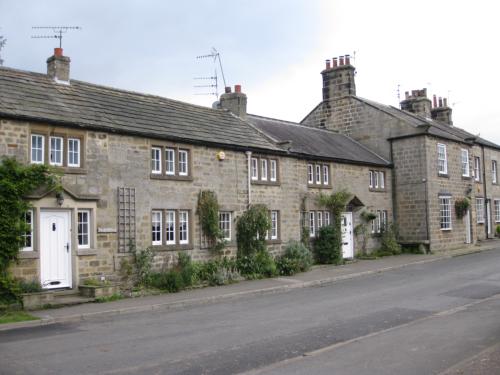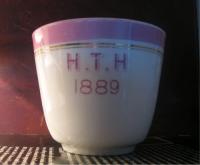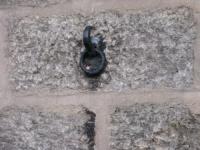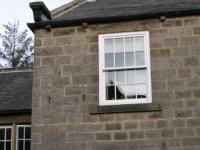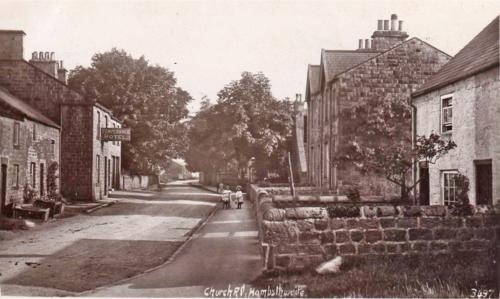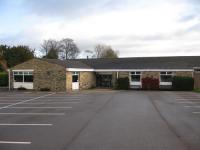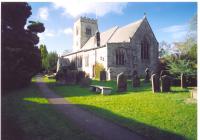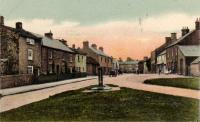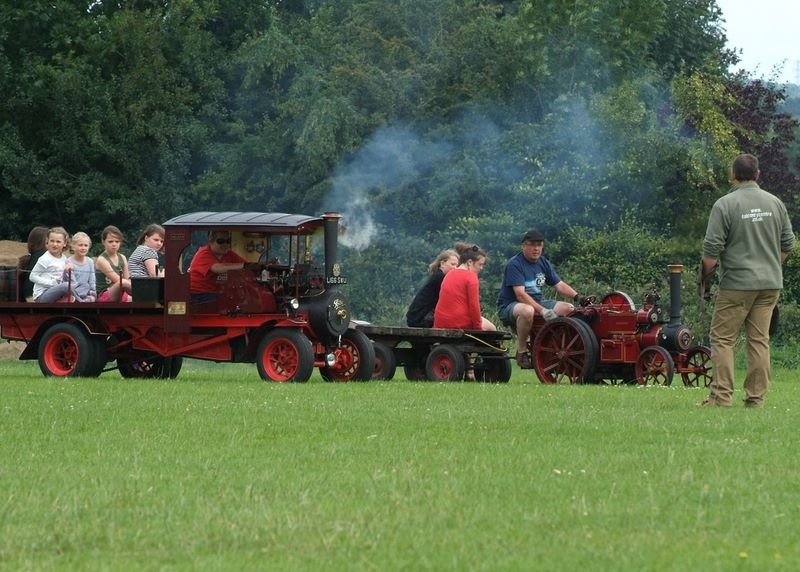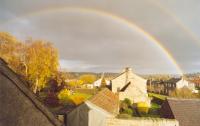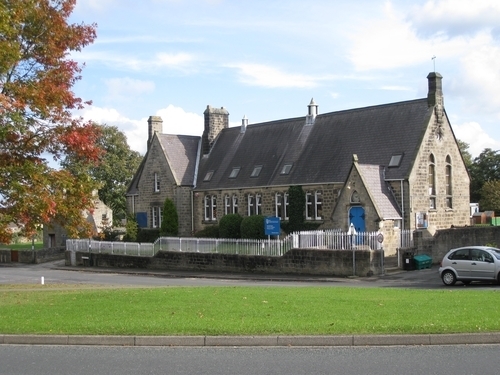Recent articles
© DT Online 2010 - 2025
| Lamb InnThe three properties shown in this photograph are (from left to right) "The End Cottage", "Lamb Cottage" and "Cornerstone House". They once formed part of a single property known as "The Lamb Inn", a licensed inn dating back as least as far as the start of the 19th Century. Early maps of Hampsthwaite show little or no buildings in Church Lane in the middle of the 18th Century but those that do reveal the Church and (on the eastern side of the road) some elongated structure which may well have comprised the Inn. Certainly by 1822 a trade directory lists William Haxby as a victualler at "The Lamb" and the first Ordnance Survey Map of 1853 shows the building and its name. In fact, the records of the Magistrates at Knaresborough make mention of licences being granted as early as 1771 for three ale-houses in Hampsthwaite the names of the licensees being "Mathew Deton, William Brown and Richard Haist". This accords with village folk-lore which remembers three public houses in the village of which only "The Joiner's Arms" remains. Unfortunately, the Magistrates did not trouble to record the names of the houses they licensed. A later trade directory of 1837 records "Ann Haxby" (? William's widow) as the inn-keeper. It is likely that the ale-house grew in size after its first beginnings. It was commonly the case for such businesses to start as an occupation for the occupant who would sell jugs of home-made beer through the window of his/her home. Success would lead to sales "on" as opposed to "off" the premises and the development of the premises to provide seating and other refreshments. The building itself would, no doubt, increase in size and there is some evidence to suggest that this was the case with "The Lamb Inn". Inspection of the front elevation of the present building reveals that the stone courses of each dwelling have been laid at different times from those of the attached houses. There are continuous vertical mortar joints between each dwelling and it is also apparent that the buildings have been extended over the years. "Lamb Cottage" has roughly constructed walls of a thickness consistent with buildings of the 18th Century and its general height, shape and layout suggest such a history. The same could be said of "The End Cottage" but it is known that most of that building was formed in the 1950's by extending "Lamb Cottage" which itself had been described in deeds of the 20th Century as an adjunct to "Cornerstone House". It seems likely that the ale-house began in "Lamb Cottage" and expanded with the construction of "Cornerstone House" which has high ceilings and only one internal supporting wall thus offering the spacious rooms required for public events and accommodation. An alternative view of the Inn's antiquity would take it back to Tudor times for one local historian writing nearly a century ago claims that the building is referred to in Leyland's Itinerary of Yorkshire prepared for Henry Vlll. This has not yet been verified but such a provenance would agree both with the observations of Speight and Grainge (see below) and with the possibility of the property having been an ancient church ale-house (see the comments below on the name of the Inn). There are traces of internal doorways connecting the two properties and also connecting Cornerstone House with the cottage (Corner Cottage) on the south side. Indeed, the Land Tax Valuation survey of 1910 reveals that Corner Cottage , at that date at least, was part of The Temperance Hotel as the following extract shows. . . Up to the time of writing, Cornerstone House did not appear to have a cellar but the discovery of the 1910 valuation has provoked further investigation. Examination of the floor of the cupboard under the stairs leading from the ground-floor hall to the first floor revealed a thin screed of cement covering a 3 – 4 inch layer of concrete. When these coverings were broken open stone steps were discovered leading down in the direction of Corner Cottage. The steps had been filled in with loose rubble. The rubble was removed until three steps were exposed before the flight was blocked off by a brick wall obviously inserted at whatever time Corner Cottage was sold off and established as a separate property. The rubble proved to contain large quantities of broken bottles and crockery and yielded eight tea-pot lids and fragments of matching tea-pots. It seems that the selling off of the southerly portion (Corner Cottage) had been the occasion of the blocking off of the cellar steps and an opportunity to discard the stock of the Hotel. The most interesting piece yielded by the rubble was an unbroken tea-cup bearing the pattern “HTH 1889”. In the stonework of "Cornerstone House" there are two iron rings inserted (for tethering horses?) and to the left of the northernmost upper window the observant eye will detect the remains of iron pegs which almost certainly supported an oblong sign (the pub sign?). How much of the building existed in 1822? It was certainly all there by 1853 and perhaps even earlier! In his book "Nidderdale and the garden of the Nidd" published in 1894, Harry Speight says of Hampsthwaite............ "There was formerly a well-known hostelry here called the Lamb Inn, which used to be frequented by the pack-horse carriers passing through the village on their way between York and Skipton; the old pack-horse stables were done away with when the present parish stables were erected by subscription in 1866. The old inn was converted into a temperance hotel five years ago. In the house is preserved a curious dagger-like weapon, which has been kept as a kind of heirloom by each succeeding owner of the property for several centuries. The handle and blade are about 18 inches long, and on the handle is the semblance of a human head. It is mentioned in ancient deeds belonging to the property, but no one seems to know for what reason. It may possibly be a relic of the old hunting days in the Forest" Note the reference to "several centuries" - in a book published in 1894! The whereabouts of the "dagger" are not known (but see the entry for Lamb Cottage for comment on the stone bench described there). An earlier historian, William Grainge, in "Harrogate and the Forest of Knaresborough", published 1871, says . . . "The next building is the Lamb Inn, which has been an hostelry from time immemorial. A few years ago it was a curious old building, thatched with ling and straw, with low walls, narrow windows, wide chimneys, and fire places still wider. Could its old walls relate all they have seen and heard what a curious history they would reveal! Alas! for the mutability of things in this world, the old Lamb has been partly rebuilt; and the interest which attached to it as a momento of the past is gone for ever. A curious old weapon is preserved as a kind of fixture in this house, and has been beyond the memory of the oldest inhabitant. It is a kind of dagger; the handle and blade being about 17½ inches in length; on each side of the handle is a guard projecting about an inch, and terminating in the figure of a human head. It is not known whence it came." . . . 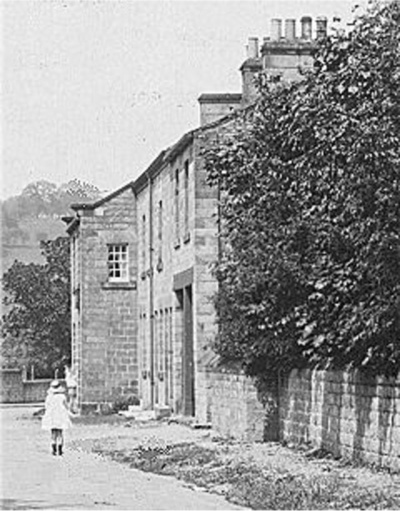 Harry Speight mentions that the premises were turned in 1889 into a temperance hotel. We are lucky to have an old photograph taken in what appears to be Victorian/Edwardian times and which illustrates the building's new role. (click photo to enlarge) Notice the dimensions of the sign! Notice also how the elevations of the cottages to the north of "Cornerstone" were then constructed. The photograph suggests that the properties were then in a generally impoverished state. Village historian George Wainwright (1917-2000 ) described what must now be Lamb Cottage in these terms: "In the house on the bridge side of the Temperance Hotel lived a gentleman called Busfield. Even for those times his seemed a rough old property: there were stone floors with no coverings at all and a small coal fire; gas, electricity and water were to come later". In fact, the planning application made in 1951 for the extension and conversion of Lamb Cottage into two dwellings described the premises even at that time as being "without services of any kind". George Wainwright (who was born and lived in one of the cottages - "Corner Cottage" on the south side of the Hotel?) said water came from a pump at the rear of his home and that the residents made use of earth closets and some red brick toilets in the vicinity of the present Church car park. The decision to abandon the licence for the Inn was described by a resident of the village in a Yorkshire Post article some years ago..... "Annie Pawson,(1901-1991) who has spent all but a handful of her 83 years in Hampsthwaite...said...'there used to be the Lamb Inn down by the church but one Sunday the landlord saw his two girls marching with the Band of Hope. He didn't even know they were members but he was so impressed he turned his premises into a temperance café". In another account she relates that ten days after this incident the licensee threw the pub sign into the river (was this the oblong board supported by the metal pegs described above?). Was the story handed down to Annie accurate? After all, the licensee was very likely a mere tenant of the property which, it has been suggested, was then owned by Mrs Wright of Hollins Hall. She would have proper concerns if the value of her property was to be affected by some change of use and it seems highly unlikely that the licensee could effect such a drastic change without her concurrence. Annie herself described Mrs Wright as "a great abstinence lady and ardent teetotaller" who personally organised weekly meetings of The Band of Hope. Could such a strong supporter of the temperance movement have tolerated the use of one of her properties for the sale of intoxicants? It seems more likely that it was Mrs Wright who instigated the end of the public house! Another villager Bernard Wilson (1919-1998) recalled that it was an aunt of his who took over the pub at the time of its "change" and added "previously, when some of the clergy came on their horses to take services, they would preach, have a little drink, preach again, then have another drink. At the end of all this they were not always fit to ride home so, until they had recovered, their horses would be put in the parish stable". The building was still described as "The Temperance Hotel" as recently as 1944 and there are residents in the village who remember the large upper room being furnished with tea-tables and that funeral parties from the Church might repair here for refreshment. Its proximity to the church makes that likely. Indeed, Annie Pawson said "The funeral tea after the service was always held at the Temperance Hotel. The lady there would ask the mourners in advance whether they wanted it with ham or potted meat sandwiches". It may not be too fanciful to suggest that the premises may also have been resorted to by the author William Makepeace Thackeray who, with his daughter, visited the church in 1863 the year before he died (his family had their origins in the village). As a Temperance hotel the premises were said to be a favourite meeting place for farmers from Otley. There must have been many social and other events held in the Inn at a time when large buildings available for public use did not exist in the village. Business was also conducted here, not least the use of the Inn for the holding of occasional inquests - this was an ordinary feature of the times when many political, judicial and other public functions were commonly held in such structures. One such event occurred in 1863 as appears from this report in the Pateley Bridge and Nidderdale Herald of Saturday October 24th in that year........ "On Thursday morning last, a young woman, named Jane Skaife, of Dacre, was found drowned in the river Nidd, having come to her death under circumstances of the most melancholy character. The deceased, though only sixteen years of age, was a remarkably fine young woman, and looked older than she really was. She was daughter of Mr. Joseph Skaife, farmer of the Pastures, Dacre, with whom she lived until Sunday last. On the afternoon of that day, in consequence of some difference with her mother, she packed up a small bundle of apparel, dressed herself for a walk, and left the house. From that time to Wednesday afternoon she wandered about the neighbourhood of Dacre, Birstwith, Hampsthwaite, &c., roaming from place to place without apparent aim or object and subsisting upon blackberries, and other wild fruits. During that time she was seen and spoken to by several persons, some of whom knew her, but were unaware of the circumstances under which she was abroad. She was last seen alive on Wednesday evening, in the neighbourhood of Hampsthwaite, at which time she was in a very low, desponding state. About eight o'clock on Thursday morning, Wm. Haxby, baker, Hampsthwaite, was in a field close to the river side, near Hampsthwaite Church, when he saw what appeared to be a human being in the water. He called to a young man named Newell, son of Mr. Robert Newell, of the Lamb Inn, who immediately repaired to the spot, and succeeded in bringing to the bank side the body of a female which was recognised as that of Jane Skaife. The body was at once removed to the Lamb Inn, to await a coroner's inquest. There were no marks of violence upon the body, and the eyes were closed as if in sleep. Whether the unhappy woman had in a fit of desperation plunged into the river, and thus put an end to her existence, or whether she had fallen asleep upon the bank and while asleep slipped into the water, will probably never be known. We fear, however, from all the circumstances, that she compassed her own death. An inquest was held upon the body yesterday afternoon at the Lamb Inn, Hampsthwaite, before Mr. Varley, deputy coroner and a respectable jury; and had not concluded when our report(er) left" In a subsequent report we learn that the jury returned a verdict of.. "Found drowned in the river Nidd, but there is no evidence to show how she came there." This sad story tells us not only about the sequel to a family rift but also illustrates the many uses of public houses. Imagine accommodating a jury, coroner, witnesses and others in the confines of what is now a small private residence! The Licensing HistorySome records survive to show the grant of ale-house licences in the period 1771-1803. The licences were granted annually by the justices sitting in Special Session and General Meeting at Knaresborough (Wapentake of Claro). Recognisances (usually £10) were taken from each ale-house keeper and one or two sureties each upon which the licensee was ..."duly licensed and allowed by the justices above named to keep a Common Inn, Ale-house, Victualling-house and Tipling house in the house wherein they now respectively dwell and not elsewhere for the selling of ale, beer and other liquors by retail pursuant to the statutes in that case for one year...(on condition that they) during all the year keep...good rule and order in their respective houses and not suffer...any unlawful games or evil practises therein contrary to the laws and statutes..." According to the records such licences for Hampsthwaite were granted to...
Notice that the number of licensees drops to two by 1781 (if not earlier) (by the death or retirement of Mathew Deighton?). None of the alehouses are named but it is reasonable to assume that one of them was the Lamb Inn. The census returns for the 19th century reveal the following licensees....
We know from Harry Speight that the premises ceased to be an Inn in 1889. The census for 1891 shows that Charles Jeffrey was then living in Hollins Lane and his occupation is described as "stonemason" and in that census Jane Barker (and a servant, Elizabeth Rhodes) is described as the manageress of the "Temperance Hotel". Origin of the Inn's name.At least one newspaper report of the 19th century refers to the Inn as the "Lamb and Flag". Many such establishments having their origins in medieval or post-medieval times had names of Christian or ecclesiastical significance. Examples include "The Mitre" and "The Salutation". "Lamb and Flag" was just such a title and referred to the Agnus Dei (the Lamb of God/Christ) usually depicted as a lamb bearing the flag of St. George as seen in the following illustration . . . 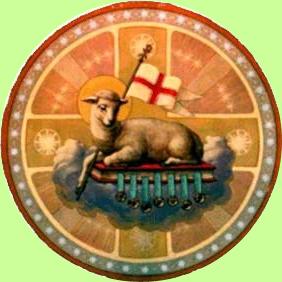 The sign board thrown into the river (see above) may well have displayed a similar illustration . . . It appears that the name of the Inn had been contracted over time and that earlier title is indicative of the ancient origins of the Inn as alluded to by Speight (Click here for information about past owners) |




